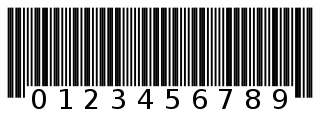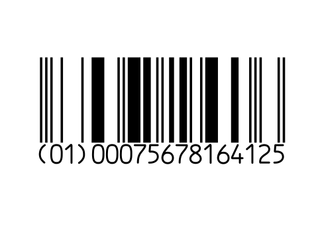
A two-out-of-five code is a constant-weight code that provides exactly ten possible combinations of two bits, and is thus used for representing the decimal digits using five bits. Each bit is assigned a weight, such that the set bits sum to the desired value, with an exception for zero.

The United States Postal Service (USPS), also known as the Post Office, U.S. Mail, or Postal Service, is an independent agency of the executive branch of the United States federal government responsible for providing postal service in the U.S., its insular areas, and its associated states. It is one of the few government agencies explicitly authorized by the Constitution of the United States. As of 2023, the USPS has 525,469 career employees and 114,623 non-career employees.

A postal code is a series of letters or digits or both, sometimes including spaces or punctuation, included in a postal address for the purpose of sorting mail.

A ZIP Code is a system of postal codes used by the United States Postal Service (USPS). The term ZIP was chosen to suggest that the mail travels more efficiently and quickly when senders use the code in the postal address.

Code 39 is a variable length, discrete barcode symbology defined in ISO/IEC 16388:2007.
POSTNET is a barcode symbology used by the United States Postal Service to assist in directing mail. The ZIP Code or ZIP+4 code is encoded in half- and full-height bars. Most often, the delivery point is added, usually being the last two digits of the address or PO box number.
In a postal system, a delivery point is a single mailbox or other place at which mail is delivered. It differs from a street address, in that each address may have several delivery points, such as an apartment, office department, or other room. Such buildings are often called multiple-dwelling units (MDUs) by the USPS.

PostBar, also known as CPC 4-State, is the black-ink barcode system used by Canada Post in its automated mail sorting and delivery operations. It is similar to other 4 State barcode systems used by Australia Post and the United Kingdom's Royal Mail, but uses an obscured structure and encoding system unique to Canada Post. This particular bar code system is used on "flats" and parcels.
CPC Binary Barcode is Canada Post's proprietary symbology used in its automated mail sortation operations. This barcode is used on regular-size pieces of mail, especially mail sent using Canada Post's Lettermail service. This barcode is printed on the lower-right-hand corner of each faced envelope, using a unique ultraviolet-fluorescent ink.

The Facing Identification Mark, or FIM, is a bar code designed by the United States Postal Service to assist in the automated processing of mail. The FIM is a set of vertical bars printed on the envelope or postcard near the upper edge, just to the left of the postage area. The FIM is intended for use primarily on preprinted envelopes and postcards and is applied by the company printing the envelopes or postcards, not by the USPS.

The International Article Number is a standard describing a barcode symbology and numbering system used in global trade to identify a specific retail product type, in a specific packaging configuration, from a specific manufacturer. The standard has been subsumed in the Global Trade Item Number standard from the GS1 organization; the same numbers can be referred to as GTINs and can be encoded in other barcode symbologies defined by GS1. EAN barcodes are used worldwide for lookup at retail point of sale, but can also be used as numbers for other purposes such as wholesale ordering or accounting. These barcodes only represent the digits 0–9, unlike some other barcode symbologies which can represent additional characters.
A multiline optical-character reader, or MLOCR, is a type of mail sorting machine that uses optical character recognition (OCR) technology to determine how to route mail through the postal system.
Remote Bar Coding System (RBCS), also called Remote Video Encoding (RVE) is a method used by the United States Postal Service to encode the address of letter-sized mailpieces that are not decipherable by a Multiline Optical Character Reader (MLOCR). When an MLOCR does not recognize a valid address on a letter, it sends an image of the mailpiece to a central RBCS (RVE) site where more sophisticated optical character recognition software is able to interpret many hand-written addresses using neural net and fuzzy logic algorithms. If this does not succeed, human operators visually examine the image and enter the address. In both cases, the data is sent back to the originating mail facility where mailpieces are then automatically matched back up with data through the use of a unique fluorescent barcode printed on the back during initial MLOCR attempt, and receive a POSTNET barcode representing the full address.
The Postal Alpha Numeric Encoding Technique (PLANET) barcode was used by the United States Postal Service to identify and track pieces of mail during delivery – the Post Office's "CONFIRM" services. It was fully superseded by Intelligent Mail Barcode by January 28, 2013.

RM4SCC is the name of the barcode character set based on the Royal Mail 4-State Bar Code symbology created by Royal Mail. The RM4SCC is used for the Royal Mail Cleanmail service. It enables UK postcodes as well as Delivery Point Suffixes (DPSs) to be easily read by a machine at high speed.

Mail sorting refers to the methods by which postal systems determine how and where to route mail for delivery. Once accomplished by hand, mail sorting is now largely automated through the aid of specialized machines. The first widely adopted mail sorting machine was the Transorma, first made operational in Rotterdam in 1930.

The GS1 Databar Coupon code has been in use in retail industry since the mid-1980s. At first, it was a UPC with system ID 5. Since UPCs cannot hold more than 12 digits, it required another barcode to hold additional information like offer code, expiration date and household ID numbers. Therefore, the code was often extended with an additional UCC/EAN 128 barcode. EAN 13 was sometimes used instead of UPC, and because it starts with 99, it was called the EAN 99 coupon barcode, and subsequently GS1 DataBar. After more than 20 years in use, there is now a need to encode more data for complex coupons, and to accommodate longer company IDs, so the traditional coupon code has become less efficient and sometimes not usable at all.
Tracking numbers are numbers assigned to packages when they are shipped. Tracking numbers are useful for knowing the location of time sensitive deliveries. It is a unique ID number or code assigned to a package or parcel. The tracking number is typically printed on the shipping label as a bar code that can be scanned by anyone with a bar code reader or smartphone.

Package tracking or package logging is the process of localizing shipping containers, mail and parcel post at different points of time during sorting, warehousing, and package delivery to verify their provenance and to predict and aid delivery.
Machine-readable postal marking may refer to:

















